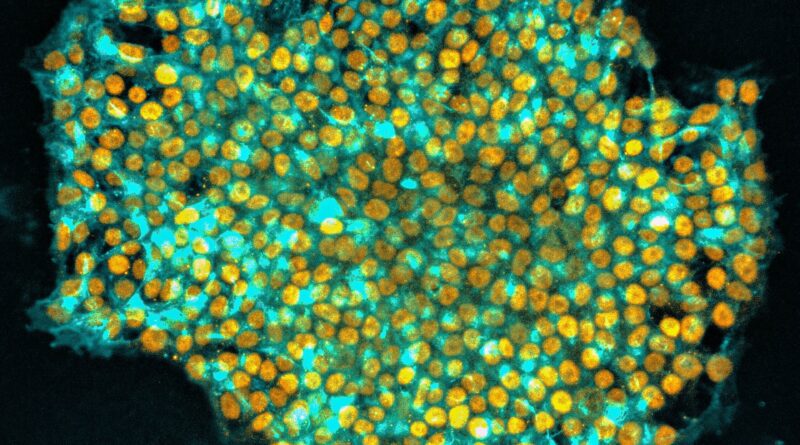A ‘memory wipe’ for stem cells may be the key to better therapies

Stem cells are special kinds of cells in our body that can become any other type of cell. They have huge potential for medicine, and trials are currently under way using stem cells to replace damaged cells in diseases like Parkinson’s.
One way to get stem cells is from human embryos, but this has ethical concerns and practical limitations. Another way is to turn adult cells from the skin or elsewhere into what are called “induced pluripotent stem cells” (iPS cells).
However, these cells sometimes carry a “memory” of the kind of cell they used to be, which can make them less predictable or efficient when we try to turn them into other types of cells.
We have found a way to erase this memory, to make iPS cells function more like embryonic stem cells. Our study is published in Nature.
Great promise for regenerative medicine
Mature, specialised cells like skin cells can be reprogrammed into iPS cells in the lab. These “blank slate” cells show great promise in regenerative medicine, a field focused on regrowing, repairing or replacing damaged or diseased cells, organs or tissues.
Scientists can make iPS cells from a patient’s own tissue, so there’s less risk the new cells will be rejected by the patient’s immune system.
Read more: Explainer: what are stem cells?
To take one example, iPS cells are being tested for making insulin-producing pancreas cells to help people with diabetes. We’re not there yet, but it’s an example of what might be possible.
Research using iPS cells is a rapidly advancing field, yet many technical challenges remain. Scientists are still figuring out how to better control what cell types iPS cells become and ensure the process is safe.
One of these technical challenges is “epigenetic memory”, where the iPS cells retain traces of the cell type they once were.
Epigenetic memory and how can it impair the use of iPS cells
To understand “epigenetic memory”, let’s first talk about epigenetics. Our DNA carries sequences of instructions known as genes. When various factors influence gene activity (turning them on or off) without changing the DNA sequence itself, this is known as epigenetics – literally meaning “above genetics”.
A cell’s epigenome is a collective term to describe all the epigenetic modifications in a cell. Each of our cells contains the same DNA, but the epigenome controls which genes are turned on or off, which determines whether it becomes a heart cell, a kidney cell, a liver cell, or any other cell type.
You can think of the DNA as a cookbook and the epigenome as a set of bookmarks. The bookmarks don’t alter the recipes, but they direct which ones are used.
Similarly, epigenetic marks guide cells to interpret the genetic code without changing it.
Read more: Explainer: what is epigenetics?
When we reprogram a mature cell into an iPS cell, we want to erase all its “bookmarks”. However, this doesn’t always work completely. When some bookmarks remain, this “epigenetic memory” can influence the behaviour of the iPS cells.
An iPS cell made from a skin cell can retain a partial “memory” of being a skin cell, which makes it more likely to turn back into a skin-like cell and less likely to turn into other cell types. This is because some of the DNA’s epigenetic marks can tell the cell to behave like a skin cell.
This can be a hurdle for using iPS cells because it can impact the process of turning iPS cells into the types of cells you want. It might also affect the function of the cells once they’re created. If you want to use iPS cells to help repair a pancreas, but the cells have a “memory” of being skin cells, they might not function so well as true pancreatic cells.
How we managed to clear iPS cell epigenetic memory and improve their function
Overcoming the issue of epigenetic memory in iPS cells is a widely recognised challenge for regenerative medicine.
By studying how the epigenome transforms when we reprogram adult skin cells into iPS cells, we discovered a new way to reprogram cells that more completely erases epigenetic memory. We made this discovery by reprogramming cells using a method that imitates how the epigenome of embryo cells is naturally reset.
During the early development of an embryo, before it is implanted into the uterus, the epigenetic marks inherited from the sperm and egg cells are essentially erased. This reset allows the early embryo cells to start fresh and become any cell type as the embryo grows and develops.
By introducing a step during the reprogramming process that briefly mimics this reset process, we made iPS cells that are more like embryonic stem cells than conventional iPS cells.
More effective epigenetic memory erasure in iPS cells will enhance their medical potential. It will allow the iPS cells to behave as “blank slates” like embryonic stem cells, making them more likely to transform into any desired cell type.
If iPS cells can forget their past identities, they can more reliably become any type of cell and help create specific cells needed for therapies, like new insulin-producing cells for someone with diabetes, or neuronal cells for someone with Parkinson’s. It could also reduce the risk of unexpected behaviours or complications when iPS cells are used in medical treatments.

